THE FLIGHTDECK • June 2021
Air Time: iconic watches inspired by aviation
In his upcoming book, Air Time: Watches Inspired by Aviation, Aeronautics, and Pilots, Mark Bernardo uncovers the stories behind the timepieces worn and made famous by the world’s most pioneering aviators. Here, he picks five that embody the spirit of flight…
Omega Speedmaster Moonwatch Professional
The Omega Speedmaster was introduced in 1957 as one of a trio of tool watches, alongside the Railmaster and Seamaster 300. The Speedy’s space odyssey began in 1962, when astronaut Wally Schirra chose the second-generation model – Ref. CK2998, with a black aluminium tachymeter bezel and new ‘alpha’-shaped hands replacing the original broad arrows – as his personal watch for the ‘Sigma 7’ mission of the Mercury programme.
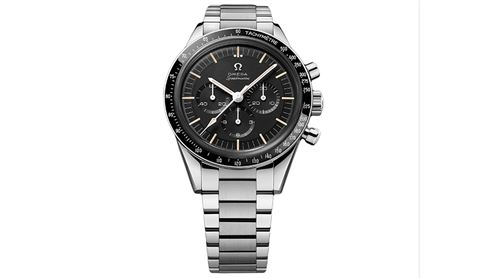
That watch, the first Omega worn in space, begat the Ref. ST 105.003, which was one of ten watches selected by Nasa engineers (though only four were actually provided) for a long and rigorous battery of tests that would lead to one watch being officially certified by the agency for use in space. In March 1965, the Speedmaster emerged victorious over competitors from Rolex, Hamilton, and Longines-Wittnauer, earning the designation it still carries today: the only piece of equipment used on every manned American space mission, from Gemini to Apollo to the present day.
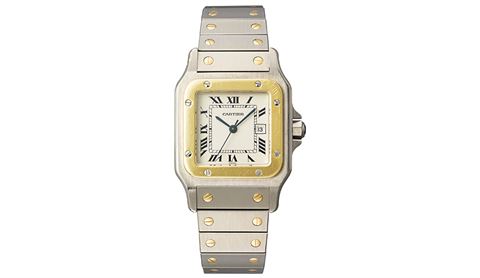
Santos de Cartier
While the Wright Brothers are acknowledged as the inventors of the airplane, they were far from alone in their quest to build the flying machine. Brazil’s Alberto Santos-Dumont was another forward-thinking pioneer. Just a few years after the Wright brothers launched their Flyer at Kitty Hawk, Santos-Dumont took off in his own heavier-than-air craft, the 14-bis, in November 1906, flying 722 feet over France to set Europe’s first aviation record. He was the man who inspired and wore the first wristwatch built for a pilot, named after the aviator by a friend, watchmaker and jeweller Louis Cartier, in 1904. Cartier based the design of his Santos-Dumont wristwatch on a square-cased pocket watch that he’d previously created, mounting it on a strap and adding elements inspired by the Art Deco style popular at the time, as well as subtle distinctions that defined it as Parisian: the exposed screws of the rounded-square bezel evoked the rivets of the Eiffel Tower, which had been erected in 1899, and the radial design of the Roman hour numerals called to mind a contemporary street map of the City of Lights.
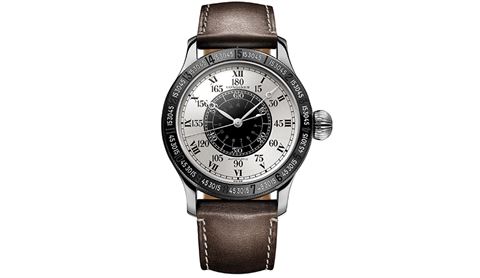
Longines Lindbergh Hour Angle
In addition to being an aviation pioneer who had received the US Medal of Honor for his historic nonstop New York to Paris flight in the Spirit of St Louis in 1927, Charles Lindbergh was also an inventor. In 1931, he collaborated with the Swiss watch manufacturer that had timed that aviation milestone for the World Air Sports Federation, Saint-Imier-based Longines, to design a timepiece that would offer unprecedented attributes to a pilot. Lindbergh’s idea for a watch that calculated a pilot’s ‘hour angle’, or longitude, in flight incorporated the ‘celestial navigation’ system. The concept for the watch’s dial and rotating numbered bezel was simple: because the Earth rotates once every 24 hours and a circle is 360°, each of the 12 hours on the dial would represent 15° of longitude. In 1931, the watch was with Clyde Pangborn and Hugh Herndon when they made the first transpacific flight by a single-engine plane, from Japan to Washington State. One year later, Amelia Earhart wore it to complete the first solo transcontinental and transatlantic flights by a woman.
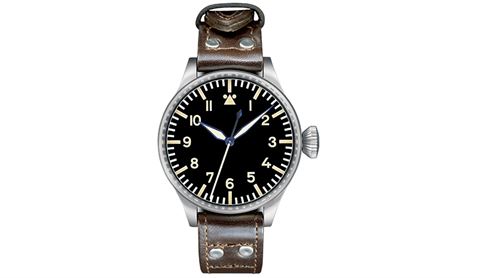
IWC Big Pilot’s Watch
When New England watchmaker Florentine Ariosto Jones founded a watch company in the German-speaking Swiss town of Schaffhausen, he gave it perhaps the most prosaic name possible: the International Watch Company. The company, now known much more popularly by its initials, IWC, exercised the same practicality when it named its first wristwatch designed especially for pilots, 1936’s Special Watch for Pilots. That watch – notable for early innovations such as a rotating bezel for recording short increments of time, large, high-contrast numerals and hands, and an escapement resistant to magnetism and temperature variations – birthed the other simply named timepiece IWC produced for the German Luftwaffe four years later in 1940: the Big Pilot’s Watch. At 55mm in diameter in steel and a sleeve-shredding 16.5mm thick, it was the largest wristwatch ever produced by the company and also, in its initial edition, now one of the rarest – only 1,000 pieces were made, all issued to German military pilots. Over the following decades, the Big Pilot’s Watch would spawn an entire collection of IWC watches constructed for use by military aviators and establish the Schaffhausen-based manufacturer as a go-to provider of such timepieces.
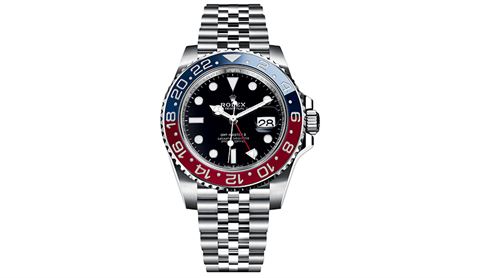
Rolex GMT-Master
Having already conquered the underwater depths with the release of its Submariner in 1953, Rolex was offered an opportunity to challenge for wristwatch supremacy in the skies a year later. In an era when transatlantic flights were becoming more common, Pan Am Airways approached the watchmaker about creating a wristwatch for its pilots that could display two time zones simultaneously. Rolex’s answer was the first GMT-Master, Ref. 6452, based on an earlier model called the Turn-O-Graph, which was equipped with a centred GMT hand that pointed to a second time zone on a rotating 24-hour bezel. The bezel’s eye-catching bicolour design – red for daylight hours, blue for night time – earned the original GMT-Master the nickname ‘Pepsi’. Actress Honor Blackman, as Pussy Galore, wore the watch in the 1964 James Bond film Goldfinger, eventually also bestowing her character’s name upon the reference.
Air Time: Watches Inspired by Aviation, Aeronautics, and Pilots by Mark Bernardo is out 29 June 2021 (£68, Rizzoli)
This article has been tagged Adventure, Technology
More from previous issues
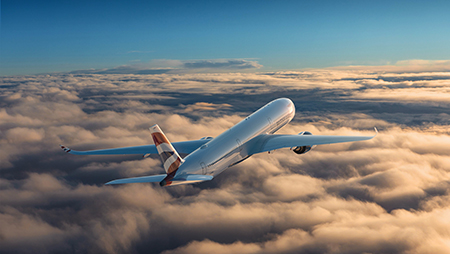
LanzaJet: a sustainable fuel partnership
Can aviation ever be carbon-free? According to our expert, the industry is closer than ever before to making green fuel a reality

Eight ways to hack the weather
Meteorological magic: our ‘natural navigator’s expert tips mean you’ll be able to spot what’s coming around the corner

The ultimate hiking kit list
Black Girls Hike founder and walking fanatic Rhiane Fatinikun whittles down her top essentials for anyone thinking of dipping a toe in the great outdoors

All-inclusive vs DIY travel: which is best?
When it comes to picking your holiday resort, does stress-free mean culture-free? Our two writers battle it out for the soul of the mighty all-inclusive
